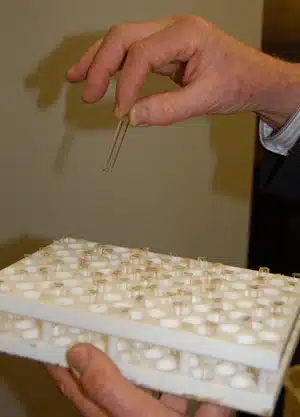ACGIH Threshold For N-Propyl Bromide Solvents

What You Should Know About The ACGIH’s Threshold For nPB Solvents
If you work with industrial chemicals, materials or solvents then you may have heard of the American Conference of Governmental Industrial Hygienists (ACGIH). The ACGIH is a scientific, but non-governmental body of industrial hygienists that publishes Threshold Limit Value (TLV) opinions on chemicals such as n-propyl bromide the base solvent for EnSolv formulations. These TLV opinions are not held to the same standards as limits set by an organization such as OSHA in the USA, but are still published in books available on the ACGIH website. You or someone else in your company might be familiar with these TLVs.
In March 2014, the ACGIH published a new TLV for n-propyl bromide (1-bromopropane). This TLV was set at 0.1ppm, and refers to “commercial grade bromopropane (99% 1-BP with 0.1%-0.2% 2-bromopropane).” 2-bromopropane is also known as isopropyl bromide (iPB). Modern nPB manufacturing processes result in nPB with <0.01% iPB contamination, which is of a pharmaceutical quality.
The 1-BP (nPB) properties referenced by the ACGIH rely to some degree on information first published in 1999 and 2000, which contains information that is out of date and inaccurate when referring to today’s purity of 1-BP. Some of the things to keep in mind regarding ACGIH TLV opinions include:
- TLVs are not determined by speaking openly with scientific experts, but in closed-
- Door meetings.
- There is no scientific consensus backing up ACGIH’s findings.
- ACGIH TLV opinions may involve conflicts of interest and uncertain science.
- The ACGIH is a not-for-profit organization that funds its activities by selling books; it is not a government-sanctioned panel of experts.
The IBSA et al. v. ACGIH lawsuit documents a number of these concerns involving the ACGIH and how they determine their TLV opinions. There is nothing worse than misinformation in our field – not only are safer chemicals such as nPB made to seem dangerous, but chemicals that are unsafe or unsuitable might be seen as acceptable alternatives.
It is of great concern to that in spite of the very demanding regulations already in effect in Europe some manufacturers of very expensive “new” fluorocarbon alternatives to the less expensive conventional solvents choose to imply that recent ACGIH recommendation for a reduction of exposure limits will have legal effect in Europe. This wrong and no credence should be given by users to any “recommendations” except those issued by government regulators.
The EU will establish DNEL (Derived No Effect Level) recommendations under the REACH legislation in due course and until these are issued all properly designed and maintained equipment is perfectly safe for use for vapour degreasing and any suggestion to the contrary may cause unnecessary confusion and restrict the use of this very useful technology.
EnviroTech urges you and others in your company not to rely solely on TLVs, but rather on official and informed sources instead (See US EPA SNAP Approval for 1-BP). For more information on the properties of nPB and related solvents, please visit www.vapour-degreasing.com or contact EnviroTech today.
We can provide you with a Material Safety Data Sheet, independent laboratory reports, product samples or technical assistance. For more information or advice please contact us by telephone on +44 (0) 20 8281 6370 or use our contact form.
Vapour degreasing solvents are supplied and supported by EnviroTech Europe Ltd. Manufactured in the United Kingdom and available on short delivery times through our dedicated team of distributors worldwide.
Share this page:
